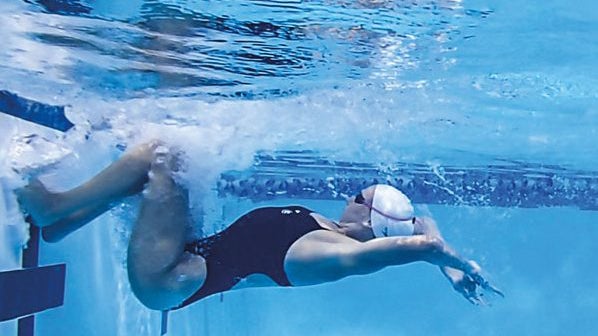The Top 5 Reasons Why Triathletes Should Flip Turn

Swimming can be daunting for many triathletes, so it may seem overwhelming and unnecessary to add more stress by asking them to add a flip turn into the mix. However, there are a number of reasons to consider learning this skill. Here, Swim Speed Secrets for Swimmers and Triathletes author Sheila Taormina’s shares her top give reasons triathletes should flip turn.
1. You can learn to do a respectable flip turn in 30 minutes or less.
Who wouldn’t want to acquire a new skill in such a short period of time? It may be rough around the edges at first, but with persistent practice you can refine your turn to be sleek and dynamic within a few weeks. Eventually the flip turn will be quicker than your open turn, so the people in your lane who gain on you at every wall will no longer have that advantage.
2. It is an athletic feat that hones your proprioceptive abilities.
Proprioception is the awareness of where your limbs and body are in space even when you cannot see them. Gaining proprioceptive abilities makes you a better athlete all around.
3. It’s a great core workout.
The turning motion involves going from a prone position to a tucked position and then back to prone. Athletes get a free core workout every length of the pool. You’ll notice your mid-section (front and back) tightening as the weeks go by.
4. You experience a unique and fast fluid flow when doing a turn, which prompts you to feel and carry that speed at the surface while swimming.
If you have a half-way decent turn, then you will push off the wall at a speed that is greater than your swimming speed, and since your body is encased in water approximately 1 – 1.5 feet below the surface, you feel the speed of the water flow past your entire body. You will learn how to carry that speed as you stroke, making you a faster swimmer.
5. You’ll feel much more like a competitive swimmer.
Rather than someone who does not feel completely at home in a pool. Acquiring the skills that experts in a sport have mastered is always a great feeling.
I hope these 5 reasons to learn to flip turn will encourage you to give it a try, but I know many of you have two concerns because I hear them often at my swimming clinics.
RELATED VIDEO: How to Do a Flip-Turn
Roadblock #1: Flip turns feel like cheating, because flip turns cut off the extra stroke into and out of the wall, and triathletes need stroking endurance for open water. Flip turns are not cheating! Flip turns actually make you swim more. It’s impossible to truly simulate the continuous swimming of race day if you are accustomed to snatching an extra breath every time you hit the wall for your open turn. Plus, open turns tempt tired swimmers to stop and take a break.
Roadblock #2: Physical concerns such as getting dizzy, getting water in the sinuses, or fear of hitting head on the bottom of the pool. These concerns are legitimate and a common issue for many people, but each one is overcome by learning the proper turning technique. Just remember this: you can learn a respectable flip turn in 30 minutes of focused effort. Once you learn to flip turn, you’ll always know how. Give flip turns a try!
In case my top five reasons to flip turn didn’t convince you, here are a few more:
- Flip turns expand your lung capacity. Because you interrupt your hard breathing to hold your breath for a few seconds about twice a minute, you expand your rib cage and lungs while also training your body to get used to holding your breath while your lungs are yelling at you for more air!
- Flip turns are fluid. Open turns are interruptions. Think of it this way: what’s the equivalent of an open turn in running? Maybe a similar interruption for runners might be breaking stride to jump a hurdle every 30 seconds or skipping for two steps instead of running.
- Flip turns help your rhythm as a swimmer. Nailing a fluid flip turn, holding a tight underwater streamline, and timing your breakout with your next stroke and breath is more than just an enjoyable feeling. For swimmers, that timing helps them improve their feel for their swimming cadence and the number of strokes they should take each lap at a given effort level.
- Open turns are hard on your wall-side shoulder.
- Open turns often keep you too high. A lazy open turn positions your body too close to the surface of the water, which leads to bad streamlines and shorter breakout times.